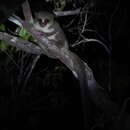tr
kırıntılardaki isimler


These lemurs are not reported to be highly vocal, but do emit some calls. Tactile communication is of importance between rivals and mates, as well as between offspring and their mother. Such communication may include grooming, playing, and aggression. Urine is used for scent marking, indicating that some chemical communication is used. Although not specifically reported for this species, visual communication, through body postures, etc, is usually used by primates.
Communication Channels: visual ; tactile ; acoustic ; chemical
Other Communication Modes: scent marks
Perception Channels: visual ; tactile ; acoustic ; chemical
Greater dwarf lemurs are under a low degree of threat. The total population is estimated to be over 100,000 animals (Mittermeier et al., 1992). Densities range from 75 to 110 animals/sq km (Nowak, 1999). In an IUCN evaluation of the lemurs of Madagascar completed in 1992, greater dwarf lemurs were not listed as a High Priority or Priority species. This species can be found in many of the parks in Madagascar (Mittermeier et al., 1992).
US Federal List: no special status
CITES: appendix i
IUCN Red List of Threatened Species: least concern
There is no known adverse affect on humans.
There is no known positive benefit to human economies. However, it has been reported that local people sometimes keep these lemurs as pets. They are quite affectionate once habituated, and come when called.
These creatures are inadequately studied, so little is known about thier role in the ecosystem. However, it is likely that they have some impact on insect populations through predation. They may help to disperse seeds from the fruits they eat, and they may help to polinate plants when the forage for nectar. To the extent that these animals are preyed upon by others, they may have some impact on predator populations.
Ecosystem Impact: disperses seeds; pollinates
Greater dwarf lemurs are omnivorous. They usually feed on fruits, flowers, and nectar (Nowak, 1999). The diet sometimes also includes insects and small vertebrates (Grzimek, 1988). Greater dwarf lemurs may also eat honey (Cockram, 1962).
Animal Foods: birds; mammals; amphibians; eggs; insects
Plant Foods: fruit; nectar; flowers
Primary Diet: omnivore
Greater dwarf lemurs are found in the eastern and northern parts of Madagascar. They might also inhabit a section of west-central Madagascar. (Nowak, 1999)
Biogeographic Regions: ethiopian (Native )
Other Geographic Terms: island endemic
Greater dwarf lemurs are arboreal (Cockram, 1962). They inhabit forests and can also be found in dry scrub areas (Grzimek, 1988; Hill, 1953).
Habitat Regions: tropical ; terrestrial
Terrestrial Biomes: forest ; rainforest ; scrub forest
A closely related animal, Cheirogaleus medius is reported to have lived nearly 20 years in captivity. It is likely that C. major has a similar maximum lifespan.
Average lifespan
Status: captivity: 15.0 years.
Average lifespan
Sex: female
Status: captivity: 10.0 years.
Average lifespan
Status: captivity: 15.0 years.
Average lifespan
Status: captivity: 8.7 years.
The length of the head and body range from 167 to 264 mm, with a mass between 167 and 600 g. The tail is longer than the body and has a length between 195 and 310 mm (Cockram, 1962; Nowak, 1999). The tail is broad at the base and tapers to the end. They eyes are large and conspicuous eyes, with a reflective tapetum lucidum for night vision (Grzimek, 1988). A black ring of hair surrounds the eyes. The ears are thin and have small, sparse hairs (Hill, 1953). Thick fur covers the rest of the body. The fur varies from gray to reddish brown on the head, back, and tail. The rump of greater dwarf lemurs is white and usually has a yellow tint (Nowak, 1999).
Range mass: 177 to 600 g.
Range length: 167 to 264 mm.
Other Physical Features: endothermic ; heterothermic ; bilateral symmetry
Sexual Dimorphism: sexes alike
Specific predators of these animals have not been reported. However, many different tenrecs, fossas, and civets may prey upon these small primates. In addition, nocturnal birds of prey and snakes may also feed upon them.
Anti-predator Adaptations: cryptic
The mating system of these animals is not known. Cheirogaleus major is reported to be solitary, with males demonstrating intolerance for one another. This suggests that mating is either monogamous or polygynous.
The estrus period of females lasts 2 to 3 days and mating usually occurs in October or November. Gestation period takes 70 days (Nowak, 1999). In December or January, females give birth in a tree cavity that is padded with leaves. Litter sizes of 2 or 3 are common. young are weaned around 45 days of age, and reach sexual maturity by the age of 10 to 14 months.
Breeding interval: It is likely that these animals breed once per year.
Breeding season: Mating usually occurs in October or November.
Range number of offspring: 2 to 3.
Average gestation period: 70 days.
Average weaning age: 45 days.
Average time to independence: 1.5 months.
Range age at sexual or reproductive maturity (female): 10 to 14 months.
Key Reproductive Features: iteroparous ; seasonal breeding ; gonochoric/gonochoristic/dioecious (sexes separate); sexual ; fertilization ; viviparous
Average birth mass: 18.1 g.
Average gestation period: 65 days.
Average number of offspring: 2.2.
Average age at sexual or reproductive maturity (male)
Sex: male: 365 days.
Females build nests where they give birth to their offspring. Offspring are fully furred at birth and have open eyes. By 3 to 4 weeks, they begin climbing and can trail after their mother (Grzimek, 1988). The period of nursing is 45 days (Nowak, 1999). A month and a half after birth, the offspring no longer rely on the mother (Grzimek, 1988).
Parental Investment: precocial ; pre-fertilization (Protecting: Female); pre-hatching/birth (Provisioning: Female, Protecting: Female); pre-weaning/fledging (Provisioning: Female, Protecting: Female); pre-independence (Protecting: Female)